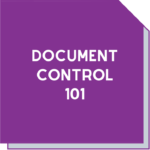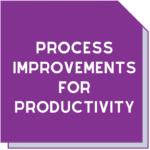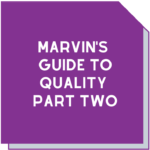Marvin’s Guide to Quality – part one
written by Maree Stuart
 In the Hitchhiker’s Guide to the Galaxy, Marvin the Paranoid Android is a robot and has a ‘brain the size of a planet’, but he is seldom asked to use this capability. Instead, people ask him to perform simple tasks, like opening doors and picking up pieces of paper.
In the Hitchhiker’s Guide to the Galaxy, Marvin the Paranoid Android is a robot and has a ‘brain the size of a planet’, but he is seldom asked to use this capability. Instead, people ask him to perform simple tasks, like opening doors and picking up pieces of paper.
Back in the real world, when it comes to Quality, how much labs use computers, software and robots varies substantially. There may be many reasons for this, including perceived cost of purchase and implementation, perceived risk, comfort with the technology, validation requirements and awareness of its existence.
In this article, we’ll explore ways in which you can enhance Quality Management through automation and digitisation.
And if you’re wondering where Marvin and the link to the Hitchhiker’s Guide to the Galaxy comes in, it’s not because I’m quirky with a passion to incorporate elements of pop culture into my writing (well there is that!). It’s because there is an upcoming event, the RACI Hitchhiker’s Guide to Laboratory Quality on 25 May, where I’ll be presenting these ideas.
But first, let’s start with the basics of Quality and Quality Management.
What is Quality and Quality Management?
You can look Quality up in a dictionary and it will tell you something like:
- the standard of something as measured against other things of a similar kind; the degree of excellence of something.
But is that all there is to it? Well, not if you’re a NATA accredited lab or ISO 9001 certified organisation.
Our learned friend, Professor Nigel Grigg, wrote an earlier article explaining that Quality is a balancing act between value, risk and cost. These attributes help us to understand a little better what Quality and Quality Management are driving at.
Value
Value is something that is added at each stage of the value chain. In the case of lab work, this includes several components:
- the efficiency and accuracy of the lab when it receives and registers a sample
- how well a particular series of steps extract the analyte of interest in the sample preparation phase
- exactly how well a particular technique in the analytical phase can measure the analyte of interest
- how efficiently and accurately the lab’s data checking and reporting practices operate
- whether the report issued by the lab can be understood by the customer and any other interested parties.
The choices made by labs in each of these components impact the relative value imported at each stage of the value chain.
For instance, if one lab were to let samples sit in the sample reception area for a day, while another lab put in the resources to minimise this time to a one-hour window by having more staff or some automation in place, the value imported into the sample reception process would differ. If you were the Lab Manager, which would you choose? What about if you were the lab customer?
Risk
Risk and risk-based thinking are now features of several quality management frameworks. Some pundits quip that you need a brain the size of a planet to come to grips with this! A risk is really the chance that something negative may happen. Risk management is simply how we manage that ‘something’. Again, we make choices as to how we manage risk.
Taking our sample receipt example, if a lab chooses to let samples sit in the sample reception area for a day, what are the chances that:
- the sample integrity for the analytes of interest is compromised, or
- the customer is not happy with receiving a result well after they needed it?
The answers may be different depending on the analyte and the customer. But in the end, it is all about the choices we make in the delivery of ‘Quality’.
Cost
Cost is the final facet in this QVRC model. There is a well-described concept of the Cost of Quality.
In any business it is important to recognise that everything we do that is beneficial to our company comes at some cost. For quality, these costs can be divided into two broad categories, each with two sub-categories:
1) Conformance costs
(a) Prevention costs – including training and education, developing documentation, audits, calibration, method validation and supplier capability surveys
(b) Appraisal costs – these include quality control, reference material purchases, proficiency testing participation and accreditation costs
2) Non-conformance costs
(a) Internal failure costs – for laboratories, these costs include retesting, downtime due to equipment failures and opportunity costs
(b) External failure costs – costs resulting from customer complaints, product recalls, the costs of losing a customer and equipment repair costs.
Quality management is really the task of balancing all these elements. It’s about the choices we make and the priorities we place in each set of circumstances to put value, risk, or cost at the front of the queue. And for that, perhaps you do need Marvin’s planet sized brain…
What we can do with technology
There are several areas in a Quality Management System where you can employ technology to improve quality in the lab. The key to choosing if something is appropriate is to run the choices through the QVRC framework. Ask yourself the types of question posed above.
Where are these opportunities?
Managing people
 People are so important in terms of quality that ISO quality management standards list personnel as the first resource to consider in an organisation. So, managing your people is critical.
People are so important in terms of quality that ISO quality management standards list personnel as the first resource to consider in an organisation. So, managing your people is critical.
Managing people is multi-faceted. In a lab you need to pay attention to things like:
- getting the right people into the lab
- ensuring their competence
- keeping them happy so you can retain your trained staff
- ensuring they are safe in the workplace
- making sure you pay your staff
- making sure you have enough people to do the various activities you engage in
- keeping records of the above
- generally acting like a human being and not a robot.
Marvin had a prototype version of the Genuine People Personality (GPP) software from SCC, allowing him sentience and the ability to feel emotions and develop a personality. The part about acting like a human being cannot be outsourced (yet) to technology. However, all the other things can be. And this can certainly make your life easier.
Think about the following:
- Does your LIMS have a feature which allows you to capture competencies of staff?
- Can your HR system link with your LIMS to help manage competencies and potential completion of work by unqualified staff?
- Can you easily measure how long one staff member takes to perform a task to help you understand the various levels of competence and where each of your staff sit with competence? There is software that allows you to measure this. Remember, too, that just because someone is faster than a colleague, doesn’t mean that they are as good at the task.
- Can your non-conformance system help you identify if there is a problem with staff and resourcing?
Document and information management
 Knowledge is key in any successful organisation. That’s why document and information control is a feature of any quality management framework. But the sheer volume of documents and information can make this task difficult.
Knowledge is key in any successful organisation. That’s why document and information control is a feature of any quality management framework. But the sheer volume of documents and information can make this task difficult.
There are ways of automating the document control process, even using simple Microsoft Office products. Microsoft also has a product, Power Apps, which allow users to automate the document control process to suit the lab’s approach to this.
There is also commercial software available for managing documents electronically. Some electronic quality management system software includes this capability. You can configure the latter to automatically connect actions arising from corrective action systems with document updates. And if this isn’t available in the system your lab uses, ask the supplier about this, or seek to customise the system by engaging a software developer.
Of course, documents should not just live in the ether or a bookcase and not read and used. Would it help the lab staff to be able to access the documents while they are in the lab in front of the LIMS? It might make them more productive.
Also consider if there are things that can be put in place to ensure that the testing or calibration process is followed. Can anything be automated to ensure that critical steps are done? By this, we mean things like the amount of sample used for a test, the inclusion of required QC, or the calculation of the final result.
Quality control
There’s more to quality control than simply putting in some extra samples or repeating the odd test. Discovering what to do when is an exercise of balancing risk, cost and value.
It’s essential to set some criteria for the results of QC activities and for this data is vital. What can your lab actually achieve? It might be far better than stated in a standard method. Remember that the point of quality control is to alert us to processes that are out of control and possible areas for improvement. Being able to deliver something better in terms of performance of a standard method can be a good thing for providing value to the customer. Or perhaps not, if the customer is not willing to pay for the extra efforts put in by the lab.
Method validation activities are the starting point for determining what a lab should do for quality control. Use the data from validation and verification activities to highlight areas of risk and hence what quality control activities to implement and when. Excel is far more powerful for interrogating this data than putting it into a Word document.
Quality control data is also a rich source for showing up non-conformances and areas of improvement. Often non-conformances from QC are not easily captured in a corrective action system. It can involve the manual creation of a corrective action report, if the analyst remembers to raise this. Investigate if you can integrate the LIMS with any electronic corrective action or quality management system to automate this process and remove the need for someone to remember.
The next episode
In our next article, we’ll continue our Quality and technology investigation by looking at facilities, equipment and purchasing.
And don’t forget to join me and my fellow presenters at the RACI Hitchhiker’s Guide to Laboratory Quality on 25 May. (Peril sensitive sunglasses will not be required).
In the meantime, if you’d like to discuss any of your Quality challenges, contact Maree (0411 540 709), Diane (0402 012 781) or email info@masmanagementsystems.com.au to set up a confidential discussion.
Remember, you don’t have to do this alone!
Download the article Marvin’s Guide to Quality part one





